511. Conservative Wall, Protected By Glass
Description
This section is from the book "The Villa Gardener", by J. C. Loudon. Also available from Amazon: The Villa Gardener.
511. Conservative Wall, Protected By Glass
A specimen of a wall of this kind is shown in figs. 65. and 66., in p. 138. and p. 140, which existed, and was found to answer perfectly for upwards of fifteen years, in the garden of Mr. Loudon's house, Porchester-terrace, Bayswater. The appearance of this glass-case is shown in the section, fig. 65 at a. The wall was flued, and the glass sashes were fixed in a wooden frame at an angle of about 45°. The wooden frame, resting its upper part against the flued wall, and its lower part being supported by another brick wall, about 18 in. high, about 3 ft. from the main wall. The frame was divided into compartments, and the glass sashes pushed along a groove in the lower part of the frame, when it was wished to open them. The sashes were removed altogether in summer.


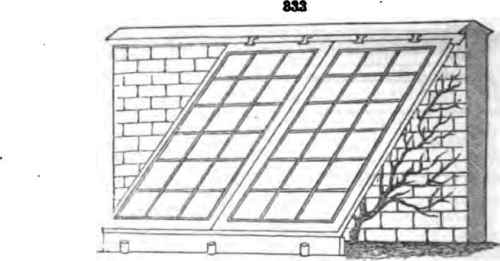
Fig. 333. shows a moveable glass-case, applied to only part of a wall to protect some particular plants.
512. In all country villas and mansions it is necessary to raise a great many young plants of pelangoniums, calceolarias, verbenas, etc, every year, to supply the place of those which are bedded out, and left in the open ground till they are killed by the frost. The most common mode of raising these plants, is to make an immense number of cuttings in the latter end of August, and the beginning of September, and to plant them in what are called store-pots, or pans, sometimes as many as fifty or sixty in a pot These pots are then placed in what are called cold pits, because no heating apparatus is required for them, where they are kept till spring. It is, therefore, evident that these cold pits are the most useful of all structures to the flower-gardener; particularly as the same wooden frames and glasses which have served for the cold pits during winter may, if not fixed with mortar on the walls of the pit, serve, after the store-pots are taken out of them in spring, as frames for hotbeds.
513. A cold pit is formed of brickwork, about 3ft high behind, and 2 ft in front The foundation walls are 9 in. thick, and those above ground 4 in. thick. The section of a pit of these dimensions, is shown in fig. 334. On the brickwork rests a frame of wood, divided into compartments, so as to hold one sash or light in each, and grooved so as to allow the sashes to slide up and down. The pit may have any number of lights required, but the usual number is four, as shown in fig. 335. One of the lights is shown in fig, 336., which is glazed with panes of glass 2 ft 6 in. long, by 9 in. wide. Each light has a handle at the upper end, to open or shut it when required. Sometimes the walls of the pit are made hollow; as it is found that the stratum, of air enclosed between the two walls, is more efficacious to keep out the cold than any mats. Sometimes merely a bottomless box of wood is used, like the wooden frame of the cold pits already described, but only for one or two lights. This box is set on the ground, and the frost is prevented from penetrating through the woodwork, by surrounding it with dead leaves, straw, litter, or even earth.
Figs. 337. and 338. show a cold pit of somewhat larger dimensions, made with a span roof in order to give room for camellias, and other similar shrubs to be kept in the centre. For this pit, it may be as well to use Hartley's patent rough glass, which is generally thought best in panes 18 in. long, and 9 in. broad, as it does not require shading; and the camellias end other similar plants are apt to have their leaves scorched if exposed to a very strong light. No means of heating these pits is shown, as, indeed, none is required; for when the pit is filled with the store pots the glass at the top is covered with mats, during severe weather, and the frost is effectually kept out.
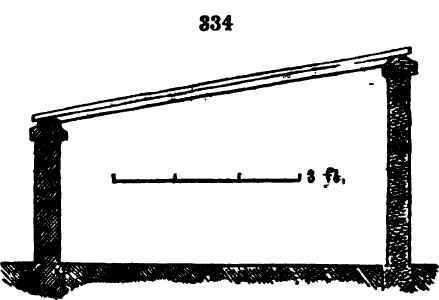
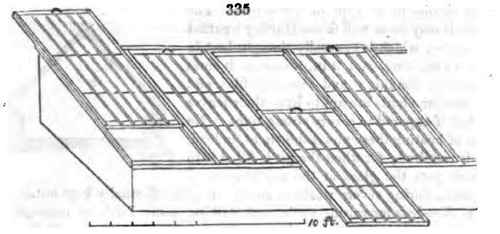
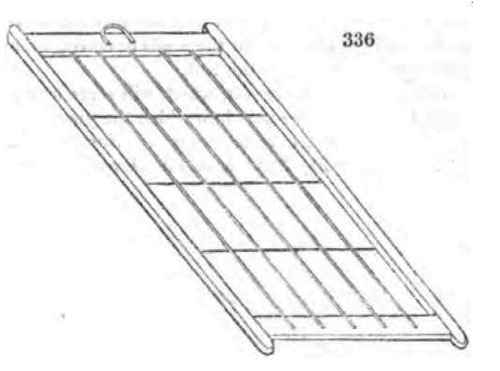

514. Hot-beds for raising seeds, and striking some kinds of cuttings, are generally found in bottomless wooden frames, with one or two lights. As however fresh manure would be too strong for raising most ornamental flowering plants, beds that have been used for cucumbers or melons are generally chosen, after the fruit has been gathered, and the plants have been taken up and thrown away. The bed is then stirred up, and perhaps a layer of fresh soil, about 6 in. thick, is laid over the surface. In this the seeds may be sown, or the cuttings planted; or the seeds or cuttings may be put in pots, and these pots may be plunged in the bed.
515. A greenhouse or pit, which will serve as a geranium-house, or heath-house for holding the pots into which the young plants raised from cuttings of geraniums, etc, have been put in spring, may be formed as shown in figs. 339. and 340. Fig, 339. shows the elevation of a small span-roofed greenhouse or pit, in which a a are air-flues, covered with plain tiles, and 6, tiles covered with sand, to receive the plants. Fig, 340. shows the plan of the same pit, in wich c c are small gratings to admit the air, and yet exclude the vermin; and d d are brick pillars to receive the tiles. This pit is admirably calculated for keeping the hardier species of greenhouse plants which are intended for bedding out, from the method of admitting air at the bottom, by which they are gradually hardened, and the ease with which the lights are taken off when more air is required, they being only hung on with hooks-and-eyes. There is also an ingenious way of covering the lights with mats, in severe weather. The mats are fastened at one end to the ridge of the roof, and at the other to a roller, the whole length of the pit; by which the mats are readily run down over the lights, and kept down without any fastening by the weight of the rollers.
They are also useful for shading, unless the rough glass is used in glazing, in which case no shading is required. This house is very suitable for heaths.
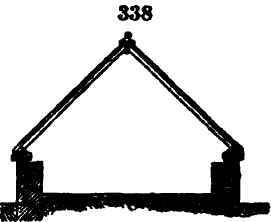

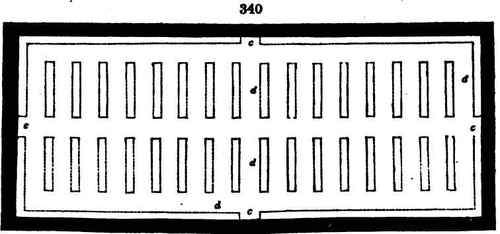
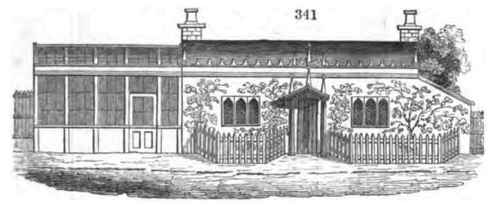
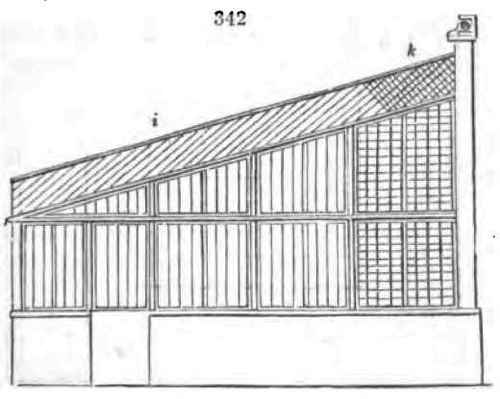
516. A small greenhouse, for young plants which are to be bedded out, may be attached to a gardener's cottage. - -as was the case at Mrs. Lawrence's villa at Drayton Green, and, as is shown in fig. 341., for the convenience of the gardener attending to the plants at his leisure hours; the house shown is of the simplest description, and it is warmed by the fireplace of the living-room of the cottage. In this house there may be troughs filled with sand, and heated by hot water pipes, or smoke flues passing under them, which will serve instead of hot beds for striking cuttings; the pots containing the cuttings being plunged into the heated sand.
517. A greenhouse, with a stove attached, is shown in figs. 342, and 343. The house has a ridge and furrow roof, and fig. 342. is a cross section through the middle of one of the ridges of the roof, in which are shown at i the oblique direction of the sash bars between the ridge and the furrow, and the panes of glass put in at right angles to the bars at k. There are openings under each ridge, in the back wall, and also in front, for ventilation.

Fig. 343. is a ground plan of a portion of this house, showing the entrance at a; a partition, by which a part of the house may be treated as a stove, bb; the hot water pipes, c c; the stage for greenhouse plants, d; cistern for water in the stove division, e; and box for Musa Cavendishii,f. The cistern and the box are formed of slabs of slate, held together by iron bolts, which pass through the two opposite plates, and are made fast with screws and nuts: h, g, h, show a vertical profile of part of a ridge on a large scale, in which g is the ridge piece, or crown of the ridge; and h h the gutters or furrows. The width of these ridges, from furrow to furrow, is about 6 ft.; and the height, from the level of the furrow to the crown of the ridge, is about 3 ft.
Continue to:


